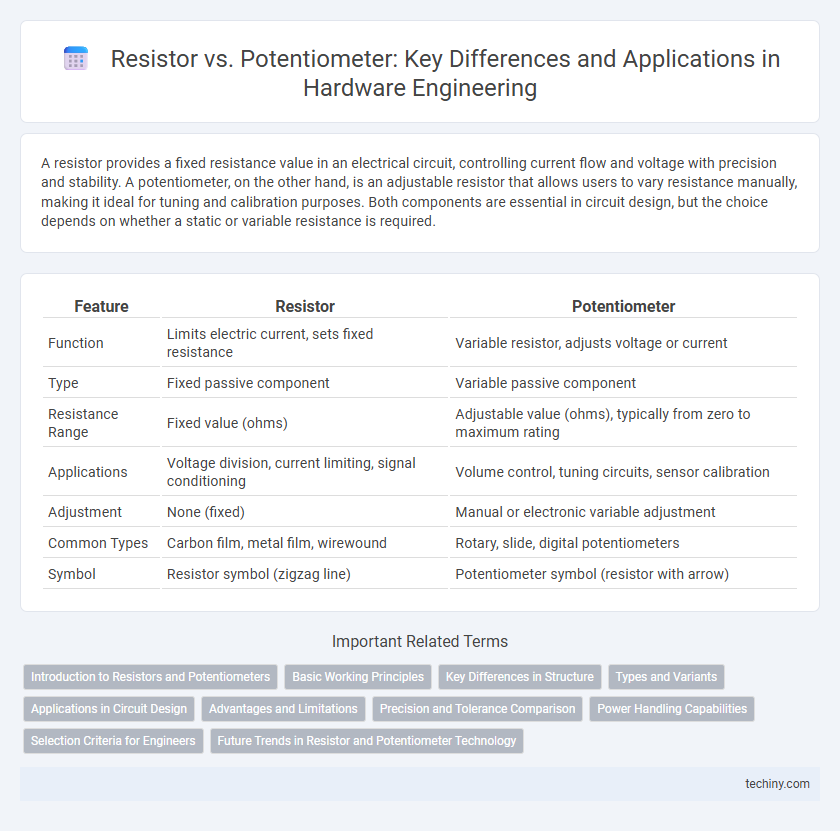A resistor provides a fixed resistance value in an electrical circuit, controlling current flow and voltage with precision and stability. A potentiometer, on the other hand, is an adjustable resistor that allows users to vary resistance manually, making it ideal for tuning and calibration purposes. Both components are essential in circuit design, but the choice depends on whether a static or variable resistance is required.
Table of Comparison
| Feature | Resistor | Potentiometer |
|---|---|---|
| Function | Limits electric current, sets fixed resistance | Variable resistor, adjusts voltage or current |
| Type | Fixed passive component | Variable passive component |
| Resistance Range | Fixed value (ohms) | Adjustable value (ohms), typically from zero to maximum rating |
| Applications | Voltage division, current limiting, signal conditioning | Volume control, tuning circuits, sensor calibration |
| Adjustment | None (fixed) | Manual or electronic variable adjustment |
| Common Types | Carbon film, metal film, wirewound | Rotary, slide, digital potentiometers |
| Symbol | Resistor symbol (zigzag line) | Potentiometer symbol (resistor with arrow) |
Introduction to Resistors and Potentiometers
Resistors are passive electrical components designed to limit current flow and divide voltage within circuits by providing a fixed resistance value, measured in ohms. Potentiometers function as adjustable resistors with three terminals, allowing variable resistance and enabling precise control of voltage output in applications like volume control and sensor calibration. Both components are fundamental in circuit design for managing electrical currents and tuning signal levels.
Basic Working Principles
Resistors provide a fixed resistance to control current and voltage in circuits, following Ohm's law to maintain consistent electrical flow. Potentiometers function as variable resistors, adjusting resistance through a movable contact that changes the length of the resistive path. This variable resistance enables fine tuning of voltage output and signal levels within electronic devices.
Key Differences in Structure
A resistor is a fixed two-terminal component designed to provide a specific resistance value, while a potentiometer is a three-terminal variable resistor with an adjustable wiper that allows resistance modulation. Resistors typically consist of a uniform resistive material, often metal oxide or carbon film, enclosed in a cylindrical or rectangular casing, whereas potentiometers include a resistive track and a movable contact for manual resistance adjustment. This structural difference enables resistors to deliver constant resistance, whereas potentiometers offer tunable resistance for applications like volume control or sensor calibration.
Types and Variants
Resistors come in fixed types such as carbon film, metal oxide, and wire-wound, each designed for specific resistance stability and power ratings. Potentiometers include rotary, linear, and digital variants, providing adjustable resistance for precise control in circuits. The choice between these components depends on whether fixed or variable resistance is required in the hardware design.
Applications in Circuit Design
Resistors provide fixed resistance values crucial for controlling current flow and voltage levels in circuit design, ensuring precise operation of electronic components. Potentiometers offer adjustable resistance, enabling dynamic tuning of voltage and signal levels in applications such as volume control, sensor calibration, and variable gain amplification. Using potentiometers allows designers to implement user-controllable settings and fine-tune circuits without replacing hardware components.
Advantages and Limitations
Resistors offer precise and stable resistance values essential for consistent circuit performance, while potentiometers provide adjustable resistance for dynamic control in applications like volume adjustment or tuning. Resistors have the advantage of simplicity, durability, and low cost but lack flexibility once installed. Potentiometers allow variable resistance but are more prone to wear, noise interference, and mechanical failure, impacting long-term reliability.
Precision and Tolerance Comparison
Resistors offer fixed resistance values with tight tolerance levels typically ranging from +-0.1% to +-5%, making them ideal for circuits requiring precise and stable resistance. Potentiometers provide adjustable resistance but generally have higher tolerance levels, often between +-10% and +-20%, which can lead to less precision in applications sensitive to exact resistance values. For high-accuracy hardware engineering projects, fixed resistors are preferred due to their superior precision and consistent tolerance compared to variable potentiometers.
Power Handling Capabilities
Resistors have fixed power ratings typically ranging from 0.125W to several watts, designed to dissipate a specified amount of heat without damage. Potentiometers generally have lower power handling capacities, often limited to less than 1 watt, due to their mechanical construction and adjustable resistance element. Selecting components with appropriate power ratings is crucial to ensure reliability and prevent thermal failure in electronic circuits.
Selection Criteria for Engineers
Engineers select resistors based on fixed resistance values, power ratings, and tolerance levels suitable for precise current control and voltage division in circuits. Potentiometers are chosen when adjustable resistance is required for calibration, tuning, or user-controlled input adjustments, considering factors like linearity, wiper durability, and resistance range. The selection depends on application-specific needs, balancing stability, precision, and adjustability for optimal circuit performance.
Future Trends in Resistor and Potentiometer Technology
Advancements in resistor and potentiometer technology are driven by the demand for miniaturization, higher precision, and enhanced durability in hardware engineering. Emerging materials such as graphene and novel thin-film composites promise improved thermal stability and resistance accuracy, while digital potentiometers integrating MEMS technology enable precise, programmable control in compact form factors. Future trends emphasize IoT compatibility, low power consumption, and integration with smart sensor systems to meet the evolving requirements of next-generation electronic devices.
Resistor vs Potentiometer Infographic

 techiny.com
techiny.com